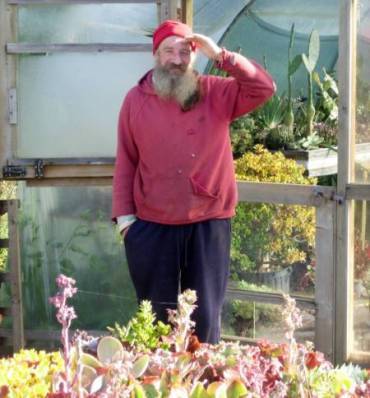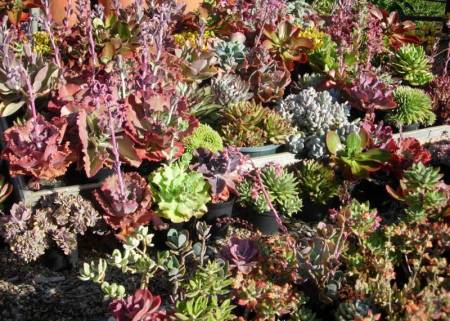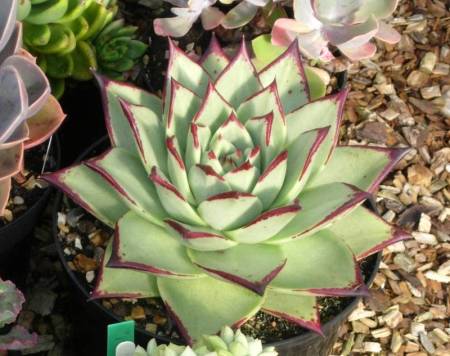|
J. White
Nurseries
Steve Purr |
|

|
This year’s holiday took
the Purr family to Honiton in Devon. A quick scan of the internet drew a
blank for nearby cactus nurseries. On a midweek trip through the centre of
Honiton, we drove past the street market and my eagle eye spotted a tray
of Echeverias on the floor between two stalls. I quickly found a parking
space and backtracked to the stall.
Much to my surprise the
entire stall was devoted to selling Echeverias. Even more surprised was
the stall-holder, Jeremy White, because I actually knew the names of the
plants he was selling. Three quarters of an hour later, and twenty pounds
poorer, I had arranged to visit his nursery next morning.
Left: Jeremy
welcomes Steve to the nursery
|
| Jeremy gave me a tour of
his nursery which consisted of two 18’ x 60’ poly-tunnels, two
30’ glasshouses and a potting shed. The plants were mostly
Echeverias and were the healthiest and largest plants I had ever
seen. All the Echeverias were staged outside for the summer but were
housed in the poly-tunnels in winter. No insecticides were used, the
only pest control was nematodes and this seems to keep the entire
collection vine-weevil free and not a single mealy-bug in sight.
Below: A well
grown sales plant of Echeveria agavoides 'Red Edge'
|

Above:
Colourful
Echeverias everywhere |
|

|
As you will see in the
photos, Jeremy has grown thousands of truly wonderful plants. His nursery
is not yet fully established and there is no mail-order as yet but
visitors are made welcome by appointment, (01404 841250).
I learned a lot from this
two hour visit and intend to change my growing methods for next season. I
wish to thank Jeremy for his hospitality and wish him well in his venture.
Steve
|
|
|
The
Garden of Wales
Ian Priestley |
OK, so you’ve all heard of the
Eden Project, near Truro in Cornwall and possibly some of you may have visited
this but did you know that it has a Welsh equivalent – The National Botanic
Garden of Wales, positioned west of Swansea, just off the M4?
Julie, Elanor and I were
holidaying in this area of Wales, early last year and thought it might well be
worth a visit. The actual setting is very grand; the world’s largest single
span greenhouse, 110m in length by 60 m width, is situated on a tall hilltop,
overlooking the former Regency garden and parklands of Middleton Hall. The glass
is above ground whilst the interior landscape of 3500 sq m is mostly either at
or below ground level.
Normally visitors would walk
about 400-600 metres up the hill to the greenhouse, but motorized transport is
also available for those who cannot actually make this. There is also a tour,
again by minibus, which takes in all of the site and which we also highly
recommend, particularly on a nice sunny day, as we thought both views and the
commentary about the site and the plans for the future were excellent.
Inside, the interior, like the
Eden project is divided into different zones. Julie and I concentrated our
sights on the S African, N American and Canary Isles plants. Some nice specimens
were on display, a very striking Aloe leucadendron “Safari Sunset”
certainly caught my eye, as did some of the Dudleyas, D. hassei, D.
lanceolata, D. anthonyi and D. pulverulenta which were bedded. On the
down side, I also noticed a few mealies on some of these, although in fairness
this had been recognised, and they were preparing to spray, as we left.
In summary, we intend to visit
again in a few years time to see what progress has been made. To any new visitor
who may be interested in plants generally, we recommend a visit if in the area.
True, there is not too great a range of cacti and succulents, but it certainly
fills a day.
Ian
|
Freshly
gathered yarns from the
world of seeds
Doug Rowland |
Doug has more snips from his life
as a seed supplier...
21. When raising Euphorbia
obesa from seeds you are presented with something like a stronger stem of
watercress after germination. Then you think to yourself, that these cannot be Euphorbia
obesa seedlings. But they are. Between the cotyledons a small green globe
will begin to grow and as it does so then the stem shrinks down gradually to
soil level. And there you have seedling E. obesa plants in the fullness of time.
22. Most of the newer Lithops
cultivars are more difficult to grow than the species due to the reduced amounts
of chlorophyll in the plants. This is why you do not see seeds or plants
regularly available in nurseries. These plants are susceptible to strong
sunlight, but if you manage to raise a few plants and keep them, then you are a
good grower. Another Lithops that is always difficult to grow and keep is L.
comptonii var. weberi. Try it from seeds sometime.
23. Seeds from dry berries such
as Ferocactus are comparatively easy to collect when ripe and germinate and grow
on. However, seeds from wet fruits such as Mammillaria are more difficult to
raise. These seeds should be washed in clean water and dried at room
temperature. But unfortunately some seeds are not, and when sown, the first
watering will often reconstitute the jelly on the seeds and cause them to suffer
fungal disease which can be rife in the warm moist conditions of a propagator
box. So the best you can do is to water using a copper fungicide solution which
will help resolve the situation.
24. Raising ferns from spores is
quite a challenge, but quite possible for the keen types following the rules of
play. The pots, soil and plant labels should all be sterilised in boiling water
and allowed to cool. Assemble soil, pots and labels and lightly sprinkle the
dust like spores on the surface of the soil in half filled 4” or 5” pots.
Cover down with clear plastic kitchen Clingfilm and secure with several elastic
bands. Place on a warm and shady shelf and allow an undetermined time to pass.
Water from the bottom with cold boiled water if and when necessary. First of all
a green velvety covering will appear on the soil surface which then grows on to
be the first stage of development. When the male and female growths have
pollinated, then small ferns will begin to appear. Leave sealed until fern
fronds fill the top part of the pot and then remove the seal and allow the young
ferns to grow on. Pot up when large enough to handle. New Zealand Tree Ferns
require a cool and shady environment when young. In habitat the trees eventually
after many years break through the forest canopy into full sun.
25. When sowing and then
labelling seeds I do not ever give them numbers or catalogue or code numbers. I
just cut up labels quite small and write the full botanical name of the item on
it. After around two years of growth it is time to see what you have got. But if
you have mislaid your key listing of code numbers to species or lost your
notebook like I did once you are then presented with some difficulty with
putting the correct names on your plants. Labelling Lithops seedlings from
colour plates in a book is just about the most frustrating pastime that I know.
26. In older textbooks I have
seen large pans of detached Echeveria leaves rooting. This looks quite good in
the picture but some species do take rather a long time to form a suitably sized
rosette to pot on. But if your leaf is broken and not detached at the stem joint
then it will not root anyway.
27. The genus Othonna
presents quite a challenge to raise from seeds. For a start, most of these
plants are winter or short day growers. These plants from South African winter
rainfall habitats are best sown in autumn. The little capsules which come from
the centre of the flowers, and are shaped like little bombs, having a smooth
nose area and a hairy windborne tail. They are difficult to count and pack,
mostly wanting to go outside the pack, rather than in, and a pair of stamp
tweezers are required for this itchy job. To improve the chances of germination
it is possible to cut into the nose area with a scalpel and remove the single
seed. Sowing a complete capsule may work, but loose coverings are susceptible to
fungus attack or rotting off of seedlings in a warm moist atmosphere of a
propagator unit.
28. It is best to sow seeds in
individual 2” pots, where they can be labelled with species name and be
contained. At one time I used to sow seeds in lines across a half seed tray.
However, one day I accidentally flooded the box and seeds floated off in all
directions. End of line sowing strategy.
29. Letter from a frustrated
enthusiast in a foreign country. Dear Doug, Thank you for sending the seeds
which have been detained locally by the Customs Department. They have asked me
to tell them the full Latin names of all the cactus seeds that are included in
the large pack of mixed seeds that you sent me in a jumbo pack. Cor Mate!
30. When applying for a
Phytosanitary Certificate to export seeds to some countries, the Family, Genus,
Species, Source and Quantity of seeds in the pack has to be declared and listed.
There are problems then with quantities of seeds such as most Crassulaceae and
some Mesembs, whose seeds are as fine as pepper grains. All we can say is that
these seeds are dust-like and uncountable, and a small quantity is enclosed for
inspection.
Doug
More from Doug’s
world of seeds in the next issue.



